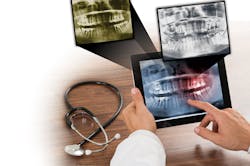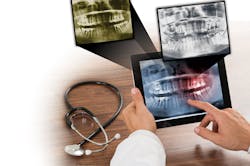Imaging software: Success in digital radiographic diagnosis relies on the software
By Ann-Marie C. DePalma, RDH, MEd, FADIA, FAADH
Several months ago I had the opportunity to buy a new car. Our old vehicle provided great transportation as our boys grew up. Now, after years of service, it needed extensive repairs and my husband and I decided it was time to move up to a newer model. We are a two-car family, and although we had bought a new car several years ago, this time was different. Technology has moved so far ahead that even starting the car and locking and unlocking the doors are technology driven. I felt as if I had to learn to drive all over again!
Digital radiography for many clinicians can feel the same way-like learning to take x-rays all over again as if you were back in school. The upsides of driving a new vehicle or learning digital radiography outweigh the discomfort of the learning curve, but getting past the "new car" feel of both can be intimidating. Digital radiography not only enhances one's diagnostic skills, but also creates value for patients and increases case acceptance.
For specific information regarding the basics of digital radiography, I recommend readers refer to my RDH magazine October 2015 Digital Radiography column, which can be viewed at RDHmag.com. This article discusses the types of intraoral digital radiography components and how each can be used to fulfill the ALARA principle. Since every practice is different regarding whether PSP (photostimulable phosphor plate) or CMOS (complementary metal-oxide semiconductor device) sensors are used, it is difficult in an article to adequately discuss all avenues of the radiological process.
In addition, the imaging software that a practice uses can be either within the practice management software or bridged to the software. With imaging software incorporated in the practice management software, patient information is automatically integrated into the imaging software with no extra steps other than opening the patient's digital chart. However, with a bridge or interface to the practice management software, the software must be opened, and then the imaging software opened, in order for images to be acquired.
Contingent on a number of factors, patients' information might need to be reentered into the imaging software. Depending on the computer hardware, when two programs are opened on the same computer at the same time, the computer can experience slowdowns or freezes. This is frustrating for the clinician and patient! Additionally, the type of computer system, monitors, and office network capability can affect the image quality.
Regardless of which imaging device, computer, or practice management program is used, nothing can be more beneficial to the learning curve than having in-office, live training. The time and expense involved in having dedicated training time for the practice benefits the team and patients in many ways. Tips and tricks of imaging, along with questions regarding the practice management software integration/interface, can be addressed, which makes the transition process as seamless as possible.
Imaging software allows clinicians to expose patient radiographs and enhance the images postexposure. Depending on the software, templates can be created that determine the correct orientation of the image. Most practices follow the "dot up" protocol on their film images. (Some chose the military style, dot down.) This allows clinicians the correct film orientation. Remember basic radiology class: "Dot in the slot, white to the light!"
However, with digital radiography the computer doesn't know whether the dot is up or down; therefore, the software must flip or mirror the image to obtain the correct orientation. Depending on the imaging software, templates can be created that allow for correct positioning of the "dot," allowing for flipping or mirroring of the image without the clinician changing it as the image is exposed.
Templates can also be created that allow the clinician to know the exact location of the image and label it appropriately. For example, upper right molar bitewing will default to teeth Nos.1-3, upper right premolar bitewing Nos.4-5, and so on. It does have limitations in that with periapicals, the software and template created will allow for quadrant choice but not tooth choice. For example, the lower right template can be chosen for a periapical of tooth No. 30, but the clinician must let the software know it is No. 30.
Additionally within the software, images can be enhanced depending on the software's capabilities to improve the contrast and brightness of the exposure. Other enhancements such as viewing specific areas in a magnified view, colorization, sharpening, smoothing, inverting, comparing, measuring, and annotating can all be used to improve the overall diagnostic abilities of the images. Depending on the software, any images that are not diagnostic may end up in the recycle bin. If the software does have a recycle bin, the images need to be deleted on a regular basis. If images remain in the software's recycle bin, it can affect the computer's performance.
Additionally, images that are not diagnostic and kept in the recycle bin during system backup will also be backed up. Outside backup services charge per amount of data, which means that the practice could be spending money backing up unusable images. With many practices moving to cloud-based software, the time it takes for the images to be sent to or retrieved from the cloud also needs to be considered. Depending on the networking capability of the practice, images loaded to and from the cloud may present concerns for the team and patients.
Regardless of what type of radiology process is used, infection control issues are critical in maintaining patient and clinician safety. It is recommended that oral health professionals wear personal protective equipment (PPE) when exposing radiographs. Cleaning, disinfecting, or sterilizing materials and equipment used in the radiological process and following manufacturers' recommendations are essential. Maintaining the aseptic chain for all computer equipment by covering or using waterproof keyboards and mice minimizes the risk of cross-contamination.
As our world becomes increasingly more technology-driven, patients want their health-care providers to be part of the digital revolution. Implementing digital radiography, whether sensor- or PSP-based, or incorporating 3-D imaging, assists in providing the "wow" factor for your practice. By involving your patients in understanding their diagnosis through digital radiography and intraoral photography, patients' case acceptance has been shown to increase. The old adage, "A picture is worth a thousand words" is so true in digital diagnosis. In the not-so-distant past, clinicians described a lesion or disease via a black-and-white small film.
How do you incorporate these "wow" moments into an already jam-packed hygiene appointment? It's not easy but it can be done, and adequate time is needed. Communication with your employer and the business team as to the importance of educating patients about all of their issues is critical to the successful integration of technology.
Learning and adjusting to digital radiography can be intimidating. As technology in dentistry continues to grow, digital radiography will be the foundation on which other technologies can be built. Becoming comfortable with all its advantages and uses will help you grow as a clinician and benefit your patients. RDH
Advances in digital radiography
Another option for imaging that has gained traction over the past few years as more dental hygienists practice in nontraditional settings is handheld imaging units. These units allow hygienists or other team members to expose radiographs with portable designs that can be used with pediatric, geriatric, and special needs patients, and in situations where electrical power is limited. With appropriate safety measures, the clinician remains close to the patient during the exposure, which allows for increased patient acceptance and comfort and decreased imaging time. PSP/CMOS sensors and the practice's imaging software can be used with these handheld devices.
One of the newest advances in digital radiography is the introduction of 2-D and 3-D imaging units. A film or PSP/CMOS sensor image is only a two-dimensional image of a three-dimensional object. Digital radiography has advanced to the extent that 3-D imaging can yield diagnostic information that was unimaginable in previous years. The 2-D x-ray image has become a virtual 3-D patient!
Depending on the unit and software, a 3-D scan of the patient can be acquired and the image can be viewed as a 2-D or 3-D image. A 3-D image can be enhanced to view specific areas from the axial, sagittal, or longitudinal aspects. When incorporated with digital impression scanning, a 3-D image can depict implant and its restorative component placement with greater accuracy.
Endodontic, orthodontic, TMD, airway treatment modalities, and implant and restorative modalities are all enhanced with the use of 3-D technology. However with the advent of 3-D technology, the clinician is bound to diagnose all information noted during the scan, including any abnormalities. When 3-D imaging was introduced, many practitioners were indiscriminately prescribing 3-D scans without using the ALARA principle. By following ADA guidelines and "scan lightly" protocols, that practice has greatly decreased. The downside to 3-D imaging is the initial investment the practice must make. As with any major purchase, there are often financing and incentive options available to assist the practice with the purchase.
ANN-MARIE C. DEPALMA, RDH, MEd, FADIA, FAADH, is a Fellow of the American Academy of Dental Hygiene and the Association of Dental Implant Auxiliaries, as well as a continuous member of ADHA. She presents continuing education programs for dental team members on a variety of topics. Ann-Marie is collaborating with several authors on various books for dental hygiene and can be reached at [email protected].

